|
Week 4: August 22-28, 2012 |
Welcome
to the McGill Bird Observatory weekly report.
Click here for a complete listing of our archives.
Comments or
questions are welcome at "mbo AT migrationresearch.org".
|
PICTURE
OF THE WEEK: |
|
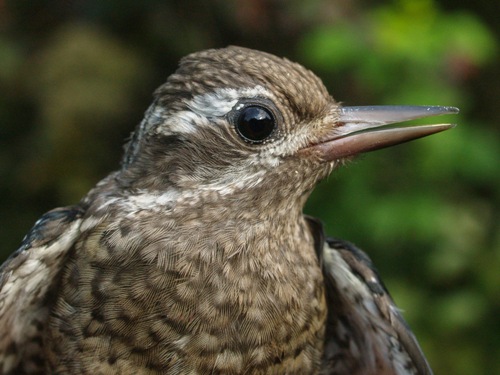
Puzzled what this is? Many field guides aren't great at illustrating juvenile birds.
This is a young Yellow-bellied Sapsucker, our first of the fall.
(Photo by Simon Duval)
-
|
|
|
THIS WEEK |
THIS FALL |
2012 TOTAL |
SITE TOTAL |
|
# birds (and species) banded |
239 (43) |
924 (57) |
2189 (80) |
37940 (108) |
|
# birds (and species) repeat |
74 (21) |
259 (29) |
597 (45) |
7010 (69) |
|
# birds (and species) return |
2 (2) |
31 (17) |
170 (26) |
1131 (38) |
|
# species observed |
84 |
110 |
159 |
207 |
|
# net hours |
560.0 |
2212.0 |
5471.8 |
64570.9 |
|
# birds banded / 100 net hours |
42.7 |
41.8 |
40.0 |
58.8 |
|
|
Note: table does not include nocturnal banding (owls) |
|
Banders-in-charge: Simon Duval, Gay Gruner
Assistants: Christine Barrie, Nicolas Bernier, Sue Bishop, Rui de Jesus, Leah den Besten, Jean Demers, Réjean Duval, Tammy Elliot, Louise Gagné, Nathalie Gendron, Tiffany Gilchrist, Monique Groulx, Alison Hackney, Fréderic Hareau, Lima Kayello, Lisa Keelty, Martin Lessard, Barbara MacDuff, Francine Marcoux, Chris Murphy, Lisa Rosenberger, Catherine Russell, Ahmad Shah, Clémence Soulard
Notes: It was another week of great weather at MBO, with all nets open for maximum hours. In fact, out of a potential 2240 net hours over the first four weeks, we have missed only 28, a record by a wide margin (our previous best was 2058 hours of coverage in 2010). We just barely missed setting a week-specific record for the number of birds banded, with 239 this week, just short of last year's 240. Still, the sason total increased to 928, well ahead of the previous best pace at this point of 869 in 2010. Of course, as much as we compare the numbers in our weekly reports, it isn't a competition - the numbers are what they are, and the key is for us to standardize our efforts sufficiently to be able to compare results from year to year even if there are inevitably differences in weather conditions and other factors. However, given the many dire stories about declining populations of various birds, we can't help but be excited when in our eighth year of fall migration monitoring, we are seeing record numbers of birds, with the peak of migration yet to come. As noted last week, diversity also seems to be particularly high this year, and for a second week in a row, we had a record number of species observed, and pushed the season total to 110, which remains a few species ahead of the previous high of 107 at this point in fall, recorded back in 2009.
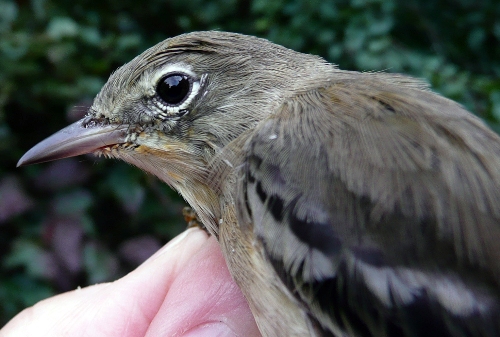
This is a good complement to last week's "confusing fall warbler" photo series. It is only the second Pine Warbler ever banded at MBO, recognizable by its drab plumage (aside from prominent wing bars) and stout bill.
(Photo by
Gay Gruner) |
Coming into this week, we had already observed 154 species on site this year, so to add another four in a single week was not an easy feat. The newcomers were a varied bunch, featuring a visit from the nearby Red-bellied Woodpecker (resident in the Morgan Arboretum), a random occurrence of a Common Nighthawk, a Pine Warbler (likely also from the Arboretum), and White-winged Crossbill, never before observed at MBO so early in fall. Another four species were new for fall: Solitary Sandpiper, Northern Harrier, Broad-winged Harrier, and Philadelphia Vireo. The Pine Warbler was one of two species banded this week that were new for 2012; the other was Black-throated Green Warbler, a reasonably common species in fall that we often barely see in spring. Also new to the fall banding list were Yellow-bellied Sapsucker and Philadelphia Vireo. This week the only species to be added to our list of this year's returns was Ovenbird.
This week’s top 10 [last week's rank in brackets]
# individuals banded |
mean # individuals observed daily |
1. Magnolia Warbler (36) [4] |
1. Common Grackle (115) [1] |
2. American Redstart (28) [2] |
2. Canada Goose (73) [2] |
3. Tennessee Warbler (21) [8] |
3. Cedar Waxwing (31) [3] |
4. Common Yellowthroat (18) [1] |
4. American Goldfinch (20) [4] |
5. Song Sparrow (16) [3] |
5. Black-capped Chickadee (18) [7] |
6. Rose-breasted Grosbeak (15) [-] |
6. Blue Jay (15) [9] |
7. Red-eyed Vireo (9) [5] |
7. American Robin (15) [5] |
7. Ovenbird (9) [10] |
8. Song Sparrow (14) [8] |
7. Indigo Bunting (9) [-] |
9. American Crow (11) [6] |
10. Black-capped Chickadee (6) [10]
10. Gray Catbird (6) [10]
|
10. Red-winged Blackbird (8) [-] |
|
Sure enough, as predicted last week, Magnolia Warbler rose to the top of the banding list this week, marking the seventh time in eight years that the species has dominated week 4 of fall. American Redstart held steady in second place, bringing the season total to 109 - already more than in our first five fall seasons, and with peak numbers traditionally occurring in week 5, that number is sure to continue to grow substantially. Tennessee Warbler numbers are already building, and will also peak in September. Common Yellowthroats, Song Sparrows, and Red-eyed Vireos continue to move in good numbers, and similarly will be around for a while yet. The biggest surprise in this week's top ten is Rose-breasted Grosbeak, with a strong push of 15 individuals, a number we've never before seen beyond the first couple of weeks of fall. Week 4 has traditionally been a slow period for Indigo Buntings, presumably a gap between banding of the local birds, and arrival of more northern migrants, but we had a good movement this week, with 9 banded. Some of our local Black-capped Chickadees and Gray Catbirds rounded out the top ten for a second straight week. Bumped off from last week's top ten were Northern Waterthrush, Mourning Warbler, Swainson's Thrush, and Veery.
Common Grackle retained a stranglehold on the list of observations for a third straight week, reflecting the continued presence of large flocks throughout much of August, which we haven't seen to this extent in previous years until later in fall. Similarly, Canada Goose numbers grew further, solidifying their hold on second place. Cedar Waxwing and American Goldfinch also stayed put in third and fourth place. In fact, aside from Blue Jay / American Crow and Black-capped Chickadee / American Robin swapping places, and Red-winged Blackbird displacing Baltimore Oriole in tenth place, this week's top ten is awfully similar to last week's.
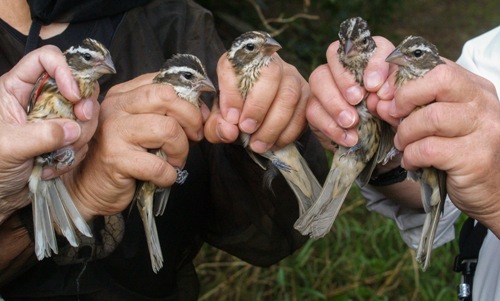
Rose-breasted Grosbeak numbers were at a record low at MBO last fall, so this week's 15 banded, including these five at the same time, are an encouraging sign that numbers are returning to normal.
(Photo by
Simon Duval) |
Hard to believe, but we have already made it through nearly one-third of the fall season. Weather, volunteers, and birds have all been great so far, and we hope for more of the same as we head into what will likely be an increasingly busy period as September brings us the peak of Magnolia, Nashville, and Tennessee Warbler migration, and toward the end of the month, the first waves of kinglets, Yellow-rumped Warblers, and White-throated Sparrows.
|
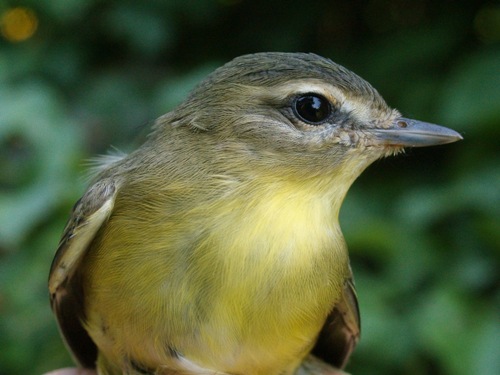
Philadelphia Vireo is primarily a September migrant at MBO, but the first one of the year came through this week.
(Photo by Simon Duval)
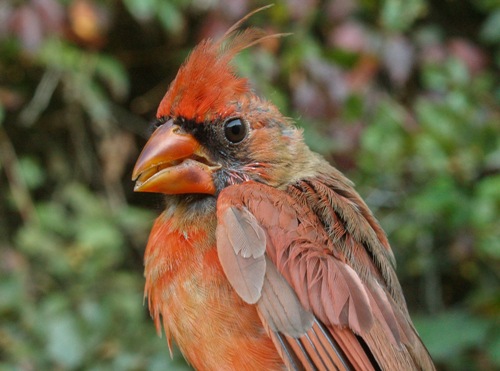
Although it is only late August, this hatch-year Northern Cardinal is already largely red.
(Photo by
Simon Duval)
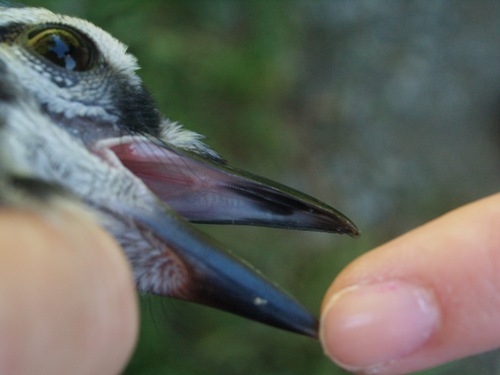
Among the research projects underway at MBO this fall is documentation of the upper mouth lining of jays and vireos to determine the reliability of this feature for ageing. This hatch-year Blue Jay already has a fair amount of black in the lining (in adults it is expected to be mostly to entirely black).
(Photos by
Simon Duval)
|






